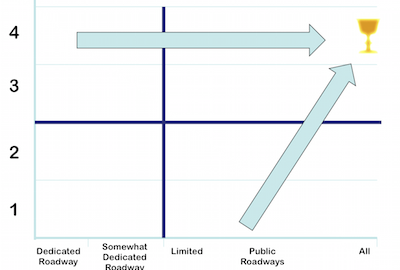Autonomous Roadmap - How We’re Going to Get There
John Estrada
The implementation and use of driverless vehicles is moving very fast indeed. Just 15 years ago, the auto industry was taking a go-slow approach to the concept of autonomous transport. DARPA changed that in 2004 when its challenges sparked an interest in both academic and commercial sectors. Then, Google committed its resources to the technology, and the idea caught on with those eager to embrace a revolutionary solution to traffic safety and ever-worsening congestion. Now, the major auto OEMs have ratcheted up their work in the driverless space.
In 2015, we see not only the organizations listed above but university research centers humming with ideas, the U.S. government investing in numerous projects, and Germany, Sweden, the United Kingdom and other countries making plans to allow driverless vehicles on their roads.
Organizations like SAE and NHTSA have tried to define this progress and technology through a series of levels. NHTSA has defined five levels (0 - 4) where 0 is no automation and 4 is a fully- autonomous vehicle that does all the driving, while SAE added an additional level to further qualify fully autonomous vehicles.
While these definitions are valuable, they don’t adequately represent where the technology stands today, and how it is progressing in the marketplace. For instance, there are already Level 4 vehicles used in specific, limited operations, such as the public rail systems in Detroit and Las Vegas, and the giant mining vehicles in Australia and Canada. A set of levels depicting automation simply isn’t adequate to track how the industry is progressing.
With this in mind, we are introducing the Driverless Transportation Autonomous Roadmap[1]. The basic concept is shown in the image below.
Along the vertical axis, we have the four NHTSA Autonomous Driving levels. What we’ve added is the horizontal axis which indicates where the vehicles can operate. The roadway to the “Holy Grail” of a fully-autonomous car that can run on any road will follow the two paths as indicated by the arrows. It will move from bottom to top as indicated by the NHTSA levels but it will also move from left to right as these vehicles are used in the real world.
We’ve begun to track at a high level how the industry is doing on the Autonomous Roadmap shown here.
Today, we’re seeing the starting points for both development lines. In production are vehicles that run autonomously on a limited group of roadways. These include the widely-used airport terminal trains along with the rail systems like those in Detroit and Las Vegas.
On the vertical axis, automobile manufacturers are introducing stand-alone autonomous features like adaptive cruise control and automated braking. In addition, some high end vehicles combine these features with lane tracking to give you a NHTSA Level 2 vehicle.
As we look to the later parts of 2015 and 2016, we see updates like those shown below with movement along both paths.
So where will we be in 2017? When will there be an autonomous vehicle that runs on All Public Roadways?
We’d like to hear what you think of the Autonomous Roadmap. Please take a moment to comment.
[1] We’d like to recognize Matthieu Van Der Elst from Michelin who scratched out a drawing at the 2014 AV Symposium which is the inspiration for the Autonomous Roadmap.




